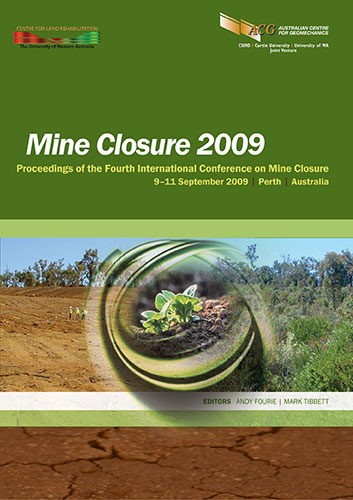Progressive closure planning at the Magellan Mine — providing some certainty in uncertain times: a case study

|
Authors: Blackman, KGA; Burne, N; Mitchell, IC; Lacy, HWB; Mackenzie, S |
DOI https://doi.org/10.36487/ACG_repo/908_4
Cite As:
Blackman, KGA, Burne, N, Mitchell, IC, Lacy, HWB & Mackenzie, S 2009, 'Progressive closure planning at the Magellan Mine — providing some certainty in uncertain times: a case study', in AB Fourie & M Tibbett (eds), Mine Closure 2009: Proceedings of the Fourth International Conference on Mine Closure, Australian Centre for Geomechanics, Perth, pp. 93-100, https://doi.org/10.36487/ACG_repo/908_4
Abstract:
Closure planning in the mining industry has been typically left until near the end of mine life, often leaving little time, financial provision or resources for effective closure planning and implementation. Ideally proponents would commit resources and time for closure planning from the commencement of operations to optimise financial return through effective planning and enhanced efficiency. Limitations associated with closing a mine in an unplanned manner include inadequate financial provision, substandard and expensive rehabilitation, and limited access to adequate equipment and materials. The lack of time to trial rehabilitation methods, the absence of corporate memory due to personnel departures, coupled with an extended post-closure monitoring and management period, will all contribute to prolonged tenement relinquishment and continuing liability for proponents. Magellan Metals Pty Ltd (the Company) owns and operates an open-cut lead carbonate mine and processing facility, located approximately 30 km west of Wiluna in the mid-west region of Western Australia, which is approximately 730 km northeast of Perth. The Company required a dynamic system to facilitate early and effective rehabilitation and closure planning over the life of the mine. Specifically, the Company required a closure system that would facilitate the establishment of closure planning tasks, allowing for tracking of these tasks and for ongoing performance monitoring. This paper describes a change in direction in mine decommissioning planning through a case study describing the development and implementation of a progressive rehabilitation and closure system. The system applied is a spatially managed closure planning system that allows proponents to track and measure closure progress via a web-based platform. Dedicated closure tasks are established within the system and the proponent is able to allocate resources against those tasks, through standard geographic information systems (GIS) information and aerial photography. The system also integrates active links to relevant supporting documentation. The system has allowed the Company to better estimate its closure liability in an uncertain and challenging financial, political and environmental climate. Its implementation has also allowed the Company to demonstrate closure planning progress to internal and external stakeholders.
References:
Australian and New Zealand Minerals and Energy Council and Minerals Council of Australia (ANZMEC/MCA) (2000)
Strategic framework for mine closure, National Library of Australia Catalogue Data, Australian and New
Zealand Minerals and Energy Council and Minerals Council of Australia, Sec. 6, pp. 35–37.
Australian Government Department of Industry, Tourism and Resources (DITR) (2006) Mine closure and completion –
Leading practice sustainable development program for the mining industry, October 2006, Commonwealth of
Australia, p. 3.
D.E. Cooper and Associates Pty Ltd (1999) Magellan Lead Project – Proposed Tailings Storage and Waste Rock
Stockpile – Technical Report, Tailings Management Notice of Intent, Project No 95–98, July, pp. 4–5.
Environment Australia (2002) Mine Decommissioning, One Booklet in Series Best Practice Environmental
Management in Mining, July 2002, Sec. 6, Commonwealth of Australia.
Keith Lindbeck and Associates (1999) Consultative Environmental Review Magellan Lead Carbonate Project (EPA
Assessment No. 1262), Mine and Concentrator near Wiluna with transport and export of Concentrate through the
Port of Geraldton, September, pp. 32–45.
Lacy, H.W.B., Koontz, D.V., Lamont, R., Henderson, D.W. and Boisvert, M.B. (2002) Progressive Rehabilitation
Locking the idea into a system to deliver results, In Proceedings Workshop on Environmental Management in
Arid and Semi-Arid areas, 29–31 May 2002, Kalgoorlie, Australia, Goldfields Land Rehabilitation Group,
pp. 113–118.
Lacy, H.W.B. and Koontz, D.V. (2002) Progressive Mine Rehabilitation Systems Taking the Static Activity of Mine
Closure into Dynamic and Auditable System, In Proceedings Workshop on Sustainable Mine Closure, Sec. 5,
23–24 October 2002, Adelaide, Australia.
Laurence, D.C. (2002) Optimising mine closure outcomes for the community – Lessons learnt, Vol. 17, No 1, Minerals
and Energy, Raw Materials Group, pp. 27–34.
Mackenzie, S., Mitchell, I. and McGuire, C. (2008) Progressive rehabilitation and closure planning using GIS-based
software at the Mungari Project, Western Australia, In Proceedings Goldfields Environmental Management
Group Workshop, 21–23 May 2008, Kalgoorlie, Australia, pp. 71–79.
PricewaterhouseCoopers (PWC) (2007) Financial reporting in the mining industry – International Financial Reporting
Standards, June 2007, Section 9 Closure and Environmental Liabilities, Energy, Utilities and Mining,
PricewaterhouseCoopers, pp. 56–59.
© Copyright 2024, Australian Centre for Geomechanics (ACG), The University of Western Australia. All rights reserved.
View copyright/legal information
Please direct any queries or error reports to repository-acg@uwa.edu.au
View copyright/legal information
Please direct any queries or error reports to repository-acg@uwa.edu.au